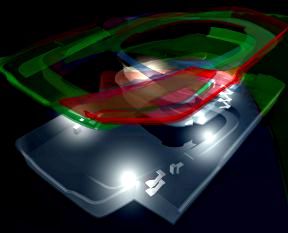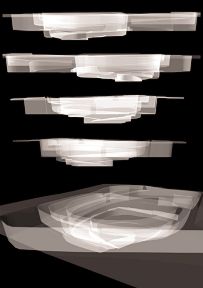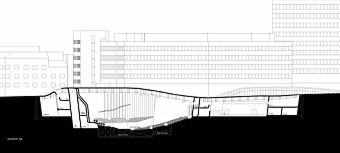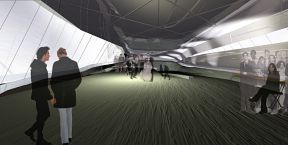
Il progetto vincitore del Concorso "Sarajevo Concert Hall"
di Urban future organisation
Il gruppo Urban future organisation ha vinto il Concorso National Concert Hall per Sarajevo, Bosnia-Erzegovina. Tale concorso internazionale di architettura è stato organizzato dal Comune di Roma, ed ha fatto parte della Biennale dei giovani artisti d’Europa e del Mediterraneo svoltasi a Roma lo scorso giugno. Sono state raccolte 920 iscrizioni e su 500 progetti presentati ne sono stati selezionati 5 per la seconda fase.

Il programma richiedeva due sale per concerti, la più grande di 1500 posti per l’orchestra sinfonica e quella di 500 posti per i concerti da camera e come aula per convegni e meeting. Inoltre, all’interno, si trovano bar, ristoranti, una libreria ed una biblioteca. Il progetto è localizzato vicino al nuovo parlamento bosniaco in mezzo a un nuovo parco urbano, dove sorgerà anche il futuro centro commerciale e culturale. Il risultato è stato annunciato lunedì 22 novembre 1999 nella sala conferenze dell’Holiday Inn, alla presenza del Governatore di Sarajevo e del rappresentante del Sindaco di Roma.
La giuria era formata da: Zaha Hadid (presidente), recente vincitrice del concorso per un centro per le arti contemporanee a Roma, Francesco Cellini preside della facoltà di architettura di Roma, Aldo Aymonino, dott. Muller, uno dei tre massimi esperti di acustica al mondo (è il consulente di Renzo Piano per l'Auditorium che sta per essere costruito a Roma) ed infine architetti, ingegneri ed urbanisti della Bosnia-Erzegovina.

La proposta vincitrice è vista come un’estensione del parco urbano prevista nel piano particolareggiato di Sarajevo. Il territorio è pensato come un elemento attivo che genera forme di pubblica attività. Il tetto giardino non è inteso solo come un’estensione della parte esterna dell’edificio ma come parte integrante del complesso stesso che genera interessanti negoziazioni spaziali.

I progettisti si sono avvalsi della consulenza dei seguenti studi ingegneristici: AKTE Engineers, BDSP Partnership, Sandy Brown Associates, Carr &Angier, Halcrow Fox and Davis Langom & Everest.
Il gruppo di progettazione è formato da: Andrew Yau (Hong Kong), Denis Balent capogruppo (Slovacchia), Katarina Larsdotter e Jonas Lundberg (Svezia), Claudio Lucchesi (Italia), Steve Hardy (U.S.A.).
L'8 dicembre 1999, a Roma, nei locali dell’ex mattatoio, in occasione della mostra denominata "enzimi", c'è stata la presentazione italiana del progetto ad alcuni tra i nostri maggiori architetti come Alessandro Anselmi, Francesco Cellini e Franco Purini che hanno tenuto una conferenza-dibattito.
Il 1° marzo 2000 il gruppo vincitore è stato invitato a Bruxelles per la presentazione ufficiale del progetto attraverso una conferenza stampa alla presenza del presidente Prodi, del governatore di Sarajevo e del Sindaco di Roma Rutelli. I lavori dovrebbero iniziare nella primavera del 2001, la comunità europea finanzierà l'opera attraverso un fondo speciale destinato ai Balcani. Attualmente, la società romana Zone Attive, con presidente Luca Bergamo, sta seguendo il progetto nel suo sviluppo.

Durante quest'anno ci sarà un processo di marketing per pubblicizzare il progetto con una serie di mostre che inizieranno a fine marzo da Roma, nell'ambito della settimana italiana della cultura organizzata dal Ministro Giovanna Melandri, poi Sarajevo, Londra, Parigi, Praga, Copenaghen, Berlino, New York, Barcellona.
Il gruppo urban future organisation ha sede a Londra e a Messina, il metodo operativo si svolge attraverso questi uffici che sono collegati tramite network. Uno staff di professionisti di origini diverse collabora, in gruppi, sin dall’inizio di ogni lavoro con un naturale arricchimento etnico-culturale.

Progettisti:
Andrew Yau (Hong Kong), Denis Balent (Slovacchia), Claudio Lucchesi (Italia), Jonas Lundberg (Svezia), Katarina Larsdotter (Svezia), Steve Hardy (USA).
The winning project of "Sarajevo Concert Hall" Competition
Urban future organisation
The project extends the public surface of the city of Sarajevo into and under the ground, forming a continuous space wrapping the foyers, the auditoriums and the service areas as well as an outdoor landscape above which bleeds into the surrounding parks.
The surrounding surface of the parkscape dissolves into and continues underground in a whirlpool movement allowing access from several critical viewpoints. The bifurcated landscaping creates openings for entrances and natural lighting. The surface also expands and contracts on its way down, accommodating different events through the building.
The landscape above allows public facilities within the building to blend with outdoor space and its events. The relationship between exterior and interior events changes according to the time of the day, weather conditions and season. The open landscape allows an unobstructed flow of people across and within the site creating a public square for the city.
The planning of the building underground eliminates the mutual impact between the concert hall and adjacent buildings as well as the necessity of external facades. The ground acts as thermal mass which increases the energy efficiency. The solar gain is minimised and overall the building environment is stable and controlled. Acoustically an underground concert hall needs no requirement for sound reductive external envelope since ground has very good acoustic properties.
The project of the Sarajevo Concert hall has the following objectives
• creation of a urban landscape in the heart of the city
• provision of an active zone for the use of the citizens of the town
• blurring of the boundaries of the building to provide for the interior of the city to serve the external activities and to blur the understanding of the extent of the building
These objectives were to be achieved by creating an external surface of the proposed park that focuses the flows towards the site and creates the interior volumes by flowing into the inside of the building as three ramps, which move into the interior of the building and congregate together in the main concert hall.
This succeeded to create an interior that allows for the park to exist above and for the most public spaces to have the most direct relationship to the outside.
The project
The city of Sarajevo has a unique setting in the landscape of Bosnia and Herzegovina. The city is organised along the valley of the river Mljecka, with the mountains to both the south and the north of the city. The site in Marinij Dvor lies between the old part of the city at the east, and the new town, to the west.
The old town with its low developments from the Austrian period allows the views through the streets and squares to the exterior of the city, and the new town contrasts the landscape with its predominantly vertical elements.
The horizontality and the topography addresses this relationship by allowing focused views through the site to maintain these connections.
There are a number of critical connections between the city and the site that are to be addressed. The proposed business park creates a central park, that links the site to the old town, the diagonal running through the site links the existing railway station to the south bank of the river, and the direct connection to the parliament building and the central square.
These critical routes meet and pass through the point of the site and concentrate the public densities in this central entrance area.
The external landscape is understood as an area of pedestrian priority zone, with direct links to the infrastructure of the city. The site will have a direct relationship to its public entrances positioned in relationship to the city, will have direct coach drop-off points, taxi and VIP drop-off, access to public bus transport and artists and VIP entrance on the south side.
The servicing of the proposed building is from below – the two level car parking is situated to the north of the site underneath the central square. From the proposed access route by the master plan, a loading bay is directly underneath to access the storage areas, delivery to bars and restaurant and for recording studio vehicles.
The outdoor foyer area can be used as a performance space during summer, the coffee bar and restaurant can spill out into the space and the artificial topography can be used as viewing mounds or amphitheatres.
This direct relationship to the outside is emphasised with the views through from the interior through the entrances and the skylights that will introduce dramatic daylight into the interior.
The most public spaces are concentrated in the top most level – the foyers, ticket offices, cloakrooms, information kiosks together with the restaurant, café and bookshop.
From these three main spaces the spiral access to the intermediate level of library, bookshop and management offices begins.
The three ramped access congregates in the main hall, which continues the ramped access in the arrangement of the seating. The level differences are negotiated in the slopes of the seating forming the visibility lines to the performance stage. In some areas the seating join to form a continuous ramped surface with joined access at certain points.
The hall, although having an overall asymmetrical layout, offers equal seat arrangement with appropriate focus on the stage. The hall has no balconies, which will mean there will be no sound pockets, and due to the circular arrangement the proximity of the seats to the stage.
The ramped access to the hall allows for the creation of side walls that will be reflecting the sound back to the orchestra and the auditorium. The concrete ceiling in the form of a triangulated coffer will diffract the sound around the hall and the reflector panels above the stage will concentrate the sound to the auditorium.
The stage has a flexible arrangement where the orchestra can be either used with or without the choir seating, and the first tier of seats can be removed to create a larger performance stage.
The secondary auditorium can serve an arrangement of a quartet performance or serve for conferences or small stage performances. The arrangement proposal for seating can be made either as flat or sloped to meet the upper level ramp. The performance stage can be raised or lowered to adapt to the suitable performance arrangement.
The rehearsals spaces are wrapped around the hall on the south and east side. The main rehearsal space is to have a similar shape to the main stage allowing for the same configuration of the musicians as the main auditorium.
Design team:
Andrew Yau (Hong Kong), Denis Balent (Slovacchia), Claudio Lucchesi (Italy), Jonas Lundberg (Sweden), Katarina Larsdotter (Sweden), Steve Hardy (USA).